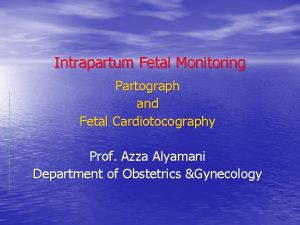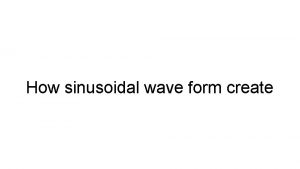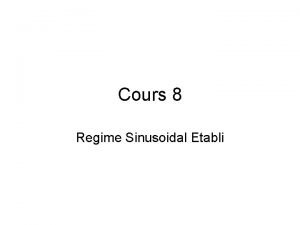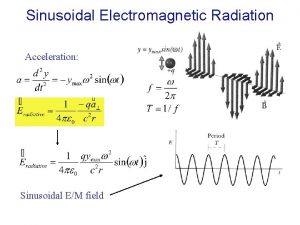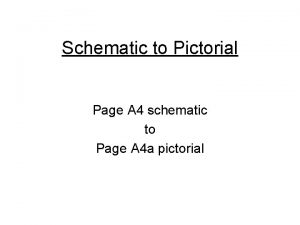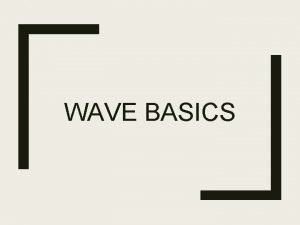FIGURE 8 1 Schematic of a sinusoidal wave















- Slides: 15

FIGURE 8. 1 Schematic of a sinusoidal wave. TALLEY Copyright © 2011 Elsevier Inc. All rights reserved

FIGURE 8. 2 TALLEY Wind waves. (a) Open ocean waves in the Gulf of Tehuantepec (February 7, 2009), under wind speeds of 20– 25 m/sec, including actively breaking waves, old foam patches, and streaks of foam (K. Melville, personal communication, 2009). (b) Example of a surface wave spectrum (spectral density) in which ocean swell and wind-seas are well separated in frequency. Source: From National Data Buoy Center (2006). (c, d) Directional wave spectrum (spectral density) and spectrum, without clear separation between swell and the wind-sea, from the NE Pacific (station 46006, 40° 53’ N 137° 27’ W, May 16, 2009. In (c), wave periods are from about 25 sec at the center of the ring to 4 sec at the outer ring. Blue is low energy, purple is high. Direction of the waves is the same as direction relative to the center of the circle. Gray arrow in center indicates wind direction. “Hs” indicates significant wave height. Figure 8. 2 c can also be found in the color insert. Source: part c is from NOAA Wavewatch III (2009) and part d is from National Data Buoy Center (2009). Copyright © 2011 Elsevier Inc. All rights reserved

(a) Significant wave height (m) and (b) peak wave period (s) and direction (vectors) for one day (May 16, 2009). Figure 8. 3 a and 8. 3 b can also be found in the color insert. Source: From NOAA Wavewatch III (2009). FIGURE 8. 3 TALLEY Copyright © 2011 Elsevier Inc. All rights reserved

FIGURE 8. 4 (a) Surf zone, looking toward the south at the Scripps Pier, La Jolla, CA. Source: From CDIP (2009). (b) Rip currents, complex pattern of swell, and alongshore flow near the head of a submarine canyon near La Jolla, CA, Photo courtesy of Steve Elgar (2009). TALLEY Copyright © 2011 Elsevier Inc. All rights reserved

FIGURE 8. 5 Types of breaking waves: (I) spilling breaker, (II) plunging breaker, and (III) surging breaker. Source: From Komar (1998). TALLEY Copyright © 2011 Elsevier Inc. All rights reserved

FIGURE 8. 6 Features of the surf zone. Source: From Komar and Holman (1986). TALLEY Copyright © 2011 Elsevier Inc. All rights reserved

Sumatra Tsunami (December 26, 2004). (a) Tsunami wave approaching the beach in Thailand. Source: From Rydevik, (2004). (b) Simulated surface height two hours after earthquake. Source: From Smith et al. , (2005). (c) Global reach: simulated maximum sea-surface height and arrival time (hours after earthquake) of wave front. Figure 8. 7 c can also be found in the color insert. Source: From Titov et al. (2005). FIGURE 8. 7 TALLEY Copyright © 2011 Elsevier Inc. All rights reserved

Schematic of a simple interfacial internal wave in a two-layer flow. Source: After Gill (1982). FIGURE 8. 8 TALLEY Copyright © 2011 Elsevier Inc. All rights reserved

Internal wave observations. (a) Temperature as a function of time and depth on June 16, 1997 at location shown in (b) (Lerczak, personal communication, 2010). (b) Map of mooring location in water of 15 m depth west of Mission Bay, California. Source: From Lerczak (2000). (c) Ocean surface west of Scripps Institution of Oceanography (map in b) on a calm day; the bands are the surface expression of internal waves propagating toward shore. (Shaun Johnston, personal communication, 2010). FIGURE 8. 9 TALLEY Copyright © 2011 Elsevier Inc. All rights reserved

Schematic of properties of internal waves. The direction of phase propagation is given by the wavevector (k, m) (heavy arrows). The phase velocity (cp) is in the direction of the wavevector. The group velocity (cg) is exactly perpendicular to the wavevector (shorter, lighter arrows). FIGURE 8. 10 TALLEY Copyright © 2011 Elsevier Inc. All rights reserved

(a) Rotary spectra from a current meter at 55 m depth in the Mid-Atlantic bight: bold is clockwise and thin is counterclockwise; the dashed curve is the modified Garrett-Munk spectrum. Source: From Levine (2002). (b) Velocity variance (variability) observed along a section crossing the Hawaiian Ridge, which is located just below the bottom of the figure at 0 km; the black rays are the (group velocity) paths expected for an internal wave with frequency equal to the M 2 tide; distance (m) is from the center of the ridge. Source: From Cole, Rudnick, Hodges, & Martin (2009). This figure can also be found in the color insert. (c) Breaking internal solitary wave, over the continental shelf off Oregon. The image shows acoustic backscatter: reds indicate more scatter and are related to higher turbulence levels. Figure 8. 11 can also be found in the color insert. ©American Meteorological Society. Reprinted with permission. Source: From Moum et al. (2003). FIGURE 8. 11 TALLEY Copyright © 2011 Elsevier Inc. All rights reserved

FIGURE 8. 12 The equilibrium tide. (a) Tide-generating force due to the moon or sun. (b) Earth-moon-sunalignment during spring tide, which also includes the case when the moon is opposite the sun Source: After NOAA (2008). (c) Alignment during neap tide. In (a), the F’s are the net gravitational acceleration at the antipodal, center, and sublunar points, and the T’s are the net tidal gravitational accelerations. TALLEY Copyright © 2011 Elsevier Inc. All rights reserved

Tides at La Jolla, California. Data from NOAA CO-OPS (2010). FIGURE 8. 13 TALLEY Copyright © 2011 Elsevier Inc. All rights reserved

Maps of (a) cotidal (phase) lines (º) and (b) tidal amplitude (cm) for the M 2 tide (lunar semidiurnal). Source: From Ray (1999). FIGURE 8. 14 TALLEY Copyright © 2011 Elsevier Inc. All rights reserved

Tidal effects on Georges Bank. (a) Schematic circulation and (b) summer temperature (°C) structure. TMF = Tidal Mixing Front. SBF= Shelf Break Zone. Source: From Hu et al. (2008). (c) Chlorophyll a concentration (mg/m 3) on October 8, 1997, from the Sea. Wi. FS satellite. Figure 8. 15 c can also be found in the color insert. Source: From Sosik (2003). FIGURE 8. 15 TALLEY Copyright © 2011 Elsevier Inc. All rights reserved
 Pseudo sinusoidal fetal heart rate pattern
Pseudo sinusoidal fetal heart rate pattern Sinusoidal wave
Sinusoidal wave The wave chapter 10
The wave chapter 10 Difference between full wave and half wave rectifier
Difference between full wave and half wave rectifier Earthquake p wave and swave travel time
Earthquake p wave and swave travel time Fourier series periodic function examples
Fourier series periodic function examples Longitudinal vs transverse waves
Longitudinal vs transverse waves Full wave rectified sine wave fourier series
Full wave rectified sine wave fourier series Longitudinal vs transverse wave
Longitudinal vs transverse wave Mechanical waves and electromagnetic waves venn diagram
Mechanical waves and electromagnetic waves venn diagram Half wave full wave rectifier
Half wave full wave rectifier Nature of sound wave
Nature of sound wave Short wave vs long wave radiation
Short wave vs long wave radiation Velocity frequency wavelength triangle
Velocity frequency wavelength triangle Mechanical waves and electromagnetic waves similarities
Mechanical waves and electromagnetic waves similarities Centre tapped full wave rectifier
Centre tapped full wave rectifier
